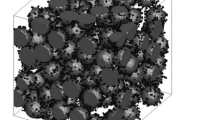Abstract
The complete computer simulation of the cathodic active layer with solid polymer electrolyte (Nafion) is carried out. The active layer structure can be described by 8 parameters. In designing the optimal structure, it is shown that to provide the high overall characteristics of the cathode and save the catalyst, 0.5 of the active layer volume should be set aside for the support grains (agglomerates of carbon particles covered with platinum and containing Nafion incorporations and microvoids). Protons and oxygen molecules must be supplied to the active layer by means of peculiar combined percolation clusters. The latter consist of a combination of support grains with either Nafion grains (to produce “protonic” clusters) or grains-voids (to afford “gas” clusters). The volume fractions of Nafion grains and grain-voids are assumed to be 0.25 and 0.25. The computer simulation of the support grain structure is also carried out. Their composition, i.e., the volume fractions of the carbon component (g e), Nafion (g ii), and microvoids (g gg), is varied. The support grains play the key role in the active layer functioning. It is impossible to organize three full-value percolation clusters (electronic, protonic, and gas); hence, one has to have one or two combined clusters in the active layer. Thus the double load fells on the support grains. Their optimal structure should not only sustain the transport of protons and electrons in the active layer but also create the best conditions for the electrochemical process in each grain. The maximum current I max (realized upon reaching the optimal active layer thicknesses Δ*) is calculated. The dependences of I max and Δ* on the main parameters characterizing the support grains (g e and g ii) are analyzed. Here, two goals are sought: (1) to obtain the high currents, (2) to provide the low consumption of platinum per power unit. To solve the first problem, one has to work with high values of g e. The second problem requires the opposite: the values of g e must be minimal possible.
Similar content being viewed by others
References
Uchida, M., Fukuoka, Y., Sugawara, Y., Eda, N., and Ohta, A., J. Electrochem. Soc., 1996, vol. 143, p. 2245.
Uchida, M., Fukuoka, Y., Sugawara, Y., Ohara, H., and Ohta, A., J. Elelectrochem. Soc., 1998, vol. 145, p. 3708.
Uchida, H., Song, J.M., Suzuki, S., Nakazawa, E., Baba, N., and Watanabe, M., J. Phys. Chem. B, 2006, vol. 110, p. 13319.
PEM Fuel-Cell Electrocatalysis and Catalyst Layers: Fundamentals and Applications, Zhang, J., Ed., London: Springer, 2008.
Malek, K., Eikerling, M., Wang, Q., Navessiu, T., and Liu, Z., J. Phys. Chem. C, 2007, vol. 111, p. 13627.
Izvekov, S. and Violi, A., J. Chem. Theory Comput., 2006, vol. 2, p. 504.
Xie, J., Wood, I.D.L., Wayne, D.M., Zawodzinski, T.A., Atanassov, P., and Borup, R.L., J. Electrochem. Soc., 2005, vol. 152, p. A104.
Mukherjee, P.P. and Wang, C.Y., J. Electrochem. Soc., 2006, vol. 153, p. A840.
Rong, F., Huang, C., Liu, Z.-S., Song, D., and Wang, Q., J. Power Sources, 2008, vol. 175, p. 699.
Rong, F., Huang, C., Liu, Z.-S., Song, D., and Wang, Q., J. Power Sources, 2008, vol. 175, p. 712.
Chirkov, Yu.G. and Rostokin, V.I., Russ. J. Electrochem., 2004, vol. 40, p. 898.
Tarasevich, Yu.Yu., Perkolyatsiya: teoriya, prilozheniya, algoritmy (Percolation: Theory, Applications, Algorithms), Moscow: Editorial URSS, 2001.
Chirkov, Yu.G., Russ. J. Electrochem., 1999, vol. 35, p. 1281.
Chirkov, Yu.G. and Rostokin, V.I., Russ. J. Electrochem., 2011, vol. 47, p. 71.
Chirkov, Yu.G. and Rostokin, V.I., Russ. J. Electrochem., 2012, vol. 48, p. 1086.
Chirkov, Yu.G. and Rostokin, V.I., Russ. J. Electrochem., 2013, vol. 49, p. 149.
Xie, Z., Navessin, T., Shi, K., Chow, R., Wang, Q., Song, D., Andreaus, B., Eikerling, M., Liu, Z., and Holdcroft, S., J. Electrochem. Soc., 2005, vol. 152, p. A1171.
Damjanovic, A., Genshaw, M.A., and Bockris, J.O’M., J. Phys. Chem., 1966, vol. 45, p. 4057.
Sepa, D.B., Vojnovic, V., and Damjanovic, A., Electrochim. Acta, 1981, vol. 26, p. 781.
Parthasarathy, A., Srinivasan, S., and Appleby, J., J. Electrochem. Soc., 1992, vol. 139, p. 2530.
Antoine, O., Bultel, Y., and Durand, R., J. Electroanal. Chem., 2001, vol. 499, p. 85.
Chirkov, Yu.G. and Rostokin, V.I., Russ. J. Electrochem., 2006, vol. 42, p. 722.
Author information
Authors and Affiliations
Corresponding author
Additional information
Original Russian Text © Yu.G. Chirkov, V.I. Rostokin, 2014, published in Elektrokhimiya, 2014, Vol. 50, No. 9, pp. 968–982.
Rights and permissions
About this article
Cite this article
Chirkov, Y.G., Rostokin, V.I. A cathode for solid polymer electrolyte fuel cells: Designing the optimal structure of the active layer. Russ J Electrochem 50, 872–884 (2014). https://doi.org/10.1134/S102319351409002X
Received:
Published:
Issue Date:
DOI: https://doi.org/10.1134/S102319351409002X



